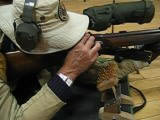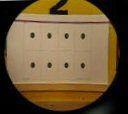Shooting the N.S.R.A.
Timed minute SKIRMISHER Competition
Please be aware that some specialist imagery may take time to load.
This site is designed for dedicated researchers, and is best viewed on desktop.
See also: ......BSA Martini International Mks. I & II ...... - .....BSA Martini International Mk.III
A SKIRMISHER 60 SECOND SHOOT IN PROGRESS
CLICK EITHER IMAGE ALONGSIDE
_____________________________________________________________________________________
Here follow copies of various notes and correspondence made, over recent years, relating to
the shooting of the Skirmisher cards in the Veteran and Post-Veteran Leagues. They could give you useful hints and a little amusement!
___________________________________________________________________________________________________
The target
available for 25 yards only - for 15 or 20 yard use the target will need to be reproduced by scaled photocopying
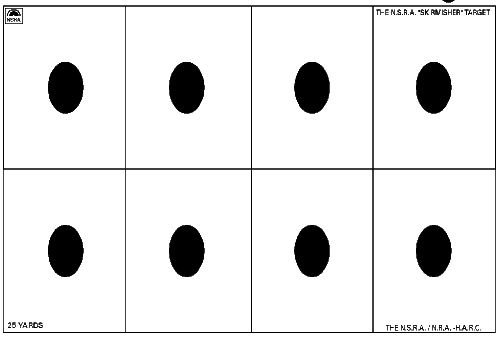
Available from The National Small-bore Rifle Association,
Lord Roberts Centre, Bisley Camp, Brookwood, Woking, Surrey, GU24 0NP
Tel: 01483 485500 .... Fax: 01483 476392 ............ Web: www.nsra.co.uk
60 seconds are allowed for shooting the
skirmisher card.
Although the NSRA rules 8.15.4 and 5.3.4 (dated Apr '99) covering time limit
shooting state that there will be NO round in the fingers at the start of
each detail, this is permitted for the HARC-MRL Veteran and Post-Veteran
league classes. No part of the round may touch the rifle.
NSRA Rule 8.15.4 Time-Limit Shooting - Small-Bore Rifle
8.15.4.1 In competitions in which the conditions specify a special time
limit (normally 90 seconds) shooters will load and fire on the signal 'Commence'
and may not fire after the signal 'Cease'. Time will be reckoned from the
signal 'Commence'. Intermediate times may be called and competitors may
use their own watch or other timing device.
8.15.4.2 If during the course of a time-limit or skirmisher shoot a card shall become displaced or a mechanical fault develop to prevent discharge of the bullet from the rifle, the shooter shall be entitled to a re-shoot.
8.15.4.3 In skirmisher competitions, a time limit of one minute is allowed.
NSRA Rule 5.3.4 Time-Limit Shooting
5.3.4.1 In individual and team competitions the following penalties apply:
5.3.4.1.1 The full possible value of one shot for loading before the signal 'Commence' is given.
5.3.4.1.2 The full possible value of any shots fired after the signal 'Cease' is given.
5.3.4.2 In Skirmisher competitions, a hit on any one of the eight oval TARGETS scores one point. Not more than two hits are allowed on any one oval target unless there are at least two hits in each of the target areas on the card and then no more than three hits and so on.
THE AMMUNITION
Rounds that feed easily into the chamber are of significant help, flat nosed target ammunition can be a potential problem here. Whilst not wishing to actively promote any particular manufacturer's ammunition, it should be said that Lapua provide their .22RF ammunition in two bullet sizes, "L" (Large ) and "M" (medium). The Medium round has a bullet around one thousandth of an inch smaller in diameter. Their larger bullet is best for deliberate shooting, especially with older barrels which may have suffered more than usual wear. However, complete accuracy is rather less critical with the Skirmisher TARGETS , but easy and speedy loading into a tight lead is a distinct advantage - probably more than you might initially believe. The smaller "M" bullet can make a really noticeable difference. You may well wish to experiment here to prove this to yourself.
*************************
Correspondence on the Skirmisher Competition
an email to HARC-MRL:
Please forward my thanks and appreciation to all those people who have
given up their time to run the Historic Winter leagues.
Not only is it enjoyable but creates a great deal of interest within the
club, (what are you shooting, where can I get one, and of course how do
you manage to hit those damn skirmisher TARGETS
?).
The reply:
The skirmishers are really very much a matter of practice and discipline (not to mention the associated expense of ammunition), along with fettling of the action of your rifle to ensure smooth operation, loading and reliable ejection.
Other critical aspects are:
1) The timing of each shot to develop a rhythm. It is quite acceptable to
have the person who is timing the one minute detail make a call every descending
ten seconds, for instance - this keeps the shooters well advised of how
time is going and prevents a 'last few seconds' panic to get the hoped for
number of rounds away.
2) Obtaining a position and hold to permit easy finding of the next aiming
mark. You can actually cant the rifle towards your ammunition block - especially
and only for the skirmishers - you are, after all, only needing what would
normally be equivalent to a six or seven scoring hit on the 1989 N.S.R.A.
target (used for the 'deliberate' card of the pair for the round you are
shooting).
3) A weighted ammunition block raised to bring the cartridges as close as possible to the receiver - to minimise hand movement.
4) A further consideration is the fore-sight element. A standard Martini
international element has a very broad band to the ring. This severely obstructs
the view through the fore-sight tunnel and makes finding the next aiming
mark much more difficult. It is helpful to actually file one down around
the outside of the ring untill the band is as thin as one could make it
without destroying the element. There is now an almost uninterrupted view
of the target through the tunnel, making it much less likely that you will
fire on the wrong black for instance.
5) Finally, there is absolutely no point in firing off rounds that are never
likely to count; it is far preferable to fire a round less and make them
all count than to get off one more shot at the expense of several counting
hits. This is really obvious, but still we have people getting 15 to 20
rounds away with only half of them hits. Others save the ammunition, fire
only twelve shots, but they all count. It can take weeks to increase that
scoring figure by one point, but only by slowly working up to it. Everything
should be done to prevent fumbles; it is no good carefully laying all the
rounds on the mat and then knocking them asunder in the rush, or picking
them up awkwardly and dropping them into the receiver "back to front";
a purpose made weighted raised level block is the only realistic answer.
An hour's effort on the woodworking bench will pay more dividends than almost
anything else.
The Martinis are generally quickest and most reliable, but some bolt-action
rifles can come surprisingly close in practiced hands - the Remington 37
is one.
These are just a few hints which may be of help to the keen Veteran or Post-Vet class shooters.
**********************
The Shooter
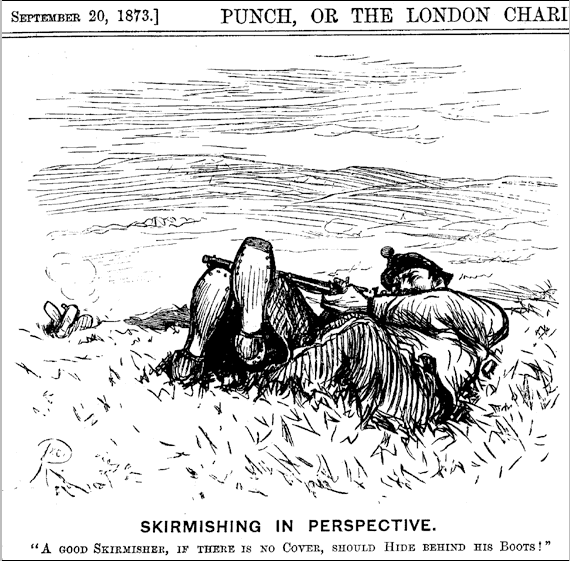
Notes sent to an enquirer
The scoring is simply - inward gauging - that a touch is a single point
scoring hit. Scores average between 6 and 16 hits - 10-12 is good, above
12 excellent, 16 plus extraordinary. Many scores are below 10. The temptation
to get away as many shots as possible in the minute is to be resisted at
all costs! We have cards coming in on which 15 to sixteen shots have been
fired, but only five or six have hit the mark. This is a complete waste
of ammunition.
No-one scores highly at first; six to eight good hits is reasonable if a
first timer takes it calmly. Build up a technique from there slowly. Ensure
the action is clean and properly adjusted and that extraction and ejection
are fine. Make sure you don't drop the rounds in back to front in your hurry
to load! Take aim properly and do not rush the let-off......... the shot
will be pulled. The competition is a summary lesson in disciplined and consistent
shooting. Even the rapid competitions produce surprises for many. They discover
that when properly shooting ten rounds in 90 seconds, they are matching
or beating their deliberate scores!
The obvious way to shoot a sequence is left to right top row and similarly for the bottom row unless you regularly shoot everything clockwise (probably the best route). It will become evident that it is ideal to put two shots on each diagram - you need to move the rifle only half as often - plus, total success would result in a tidy sixteen point score if the clock is completed. Perfection would then be to start round again putting a third shot on each diagram!
It must be remembered here that up to TWO shots will count on each diagram initially. Any third shot placed in any diagram's rectangle, before ALL have two shots already evident, will be a lost point ( it will not be counted). Thus it is safest to put two on each aiming mark first as you go around your selected route. Losing your place and putting a third shot in a rectangle can lose you a match, such is the competition. It has to be acknowledged that, if you are one of those in the closely competed divisions who obtain high scores on the deliberate cards, the Skirmisher can easily be the decider; practise makes perfect ( at the expense / expenditure of ammuntion !) and will pay dividends.
Lastly, laying the rounds on the mat is not a good idea. A good wooden ammunition block, raised up about six inches from the floor, with well spaced holes for ease of picking a round up between the fingers and with a capacity of fifteen to twenty rounds, is the order of the day. You may not shoot them all, but when you fumble and drop rounds under your elbows, you need spares! You cannot afford the time to search the floor for the only available round !
Good Luck
**********************************************************
A lady competitor wrote:
Dear HARC-MRL,
very many thanks for the results today. May I add my thanks to you all. I run the county teams so I know how time consuming it all is, albeit from the other end! What struck me was how close we all were in my division (Vet 3) Only a small handful of points separating all of us... the fact that I won in the end was more good luck than anything else...5 of us could have tied ! I don't think that there was any doubt that we were all in the right division. It is a good way to sort out the divisions, provided that people don't abuse the system...and I don't think that we do...you'd soon sus us out!!! Very many thanks and look forward to next winters effort! How on earth can people get away so many shots at the skirmisher? Apart from focussing I have to dig the empty cases out , or shoot dripping in WD40...not ladylike...not the same as Chanel !!!
The reply:
Dear ............
There are a few things that can be done to help with Skirmisher shooting.
I mention these with the understanding that you may well already be taking
them into account. These points are, though, perhaps worth passing to fellow
competitors who may not be so doing.
One way of saving those split seconds, which mount up through the minute,
is to use a tall ammunition block. This should be weighted at its base,
and constructed to bring the rounds almost up to the level of the action.
You would be surprised at the overall time lost in repeatedly moving your
hand and arm from the receiver to a block at ground level. A couple of our
members even use the old Parker-Hale "Quick Loader" which side
mounts easily onto the action retaining screw of the BSA Martini, but this
only holds ten rounds - a figure which many manage to exceed! One enterprising
soul has even glued two of these together to accommodate twenty rounds close
to the receiver. These approaches really can make a difference; ( trade
secrets are being passed on here!). I perform best with my own 12/15, but
simply with an elevated block beside me.
The employment of an unusual position or hold can pay dividends. I lean
significantly towards my ammunition block in order to facilitate loading
and cut down hand movement. I would never do this for a deliberate or normal
rapid shoot. Surprisingly, the rather perverse away-from-the shoulder cant
appears to have a minimal effect on the point of impact.
It is vital that the breech-block loading chute is adjusted to line up perfectly
with the chamber. A little high or low and rounds can flick sideways at
the mouth of the chamber and jam in the breech. The correct position of
the breech-block on many Martinis has been lost by the injudicious fettling
of the sear or bent in an attempt to improve the pull-off. The trigger pull
may be improved, but smooth loading can be seriously impaired.
Smooth extraction and firm ejection are critical. Extraction can be a problem
particularly if the chamber is eroded or even just in need of clearing of
a build-up of bullet lubricant. Unless something is seriously amiss with
the action, ejection is usually quite reliable on the Martinis; however,
a significant degree of panache is justified in lowering the under lever.
This ensures the clean ejection of the case from the receiver and minimises
the risk of the empty case dropping back into the receiver and obstructing
the loading of the next round.
Most of this advice could be construed as "teaching granma' to suck
eggs", but it is not unusual to see someone not putting the simplest
of these points into practice.
The use of lubricants to smooth things along (e.g.WD40) sounds to be a risky
business. If transferred to the fingers, it may perhaps lead to the rounds
popping out of the grip of the finger-tips at a critical moment - rather
like a wet bar of soap! Any lubricant on the cartridge case may result in
varying chamber and breech-block or bolt-head pressure with the case unable
to properly obdurate. In 22" RF barrels this may not actually be as
dangerous as in a full-bore rifle, but it could possibly result in erratic
elevation.
Focussing is altogether another matter! Eyesight deterioration as a result
of advancing years, or perhaps for some other reason, is an almost an inevitability.
The speed of the eye's accommodation reduces and, without the luxury of
time to focus that is available in a deliberate shoot, you can find yourself
obliged to let the shot go at a 'fuzzy egg' contained within the fore-sight
ring. In fact, as long as that blurred blob is centrally placed - and any
lens prescription for astigmatism is correct - then there is every chance
of finding the mark! Smooth trigger pull is far more critical with Skirmisher
shooting. More potential hits are lost to rushing or snatching the let-off
than almost anything else. Only practice can develop the necessary rythm.
One thing that can be done to improve the sight picture and speed up location
of the next aiming mark on the target, is to use a really thin ring element.
Some elements have ring widths so great that the task of finding the correct
black quickly is not easy - particularly with the standard elements fitted
to the Internationals - where used in Post Veteran Class. These obscure
a large percentage of the area of the fore-sight tunnel. It is not perhaps
an easy thing to do, but reduction of the ring width is possible with a
fine diamond file. I have in this way produced almost wire-like rings which
aid rapid pick-up of the required aiming mark and cut the risk of wasting
points by firing on the wrong one!
There is a temptation to shoot clockwise round the card once and, if there
is time to fire more than ten rounds, to return to the top left diagram
and start around the target again. It is, without doubt, advantageous to
shoot two rounds at each aiming mark, and this will only marginally increase
the risk of losing track of where you are on the target. A fumble of a round
or failed ejection of the empty case is the usual cause of a break of concentration
which loses your ongoing count of blacks that have been fired on.
There is little argument in favour of a bolt action rifle for Skirmisher
shooting. Having said that, Dave Parrish has achieved a remarkable number
of rounds fired in the minute, at the same time scoring hits - more than
twice as many as the best figures obtained by anyone in our leagues. But
this was done with a rifle he built especially for the purpose.
The Remington 37 has one of the best off-the-shelf bolt actions for the
purpose. It is perhaps slightly better than a Winchester 52. The bolt of
the R37 has quite a short travel and the action an easy loading receiver.
As long as the round is dropped in straight, the round will be driven cleanly
into the breech. The trigger is 'as good you got' for the time. Another
rifle which offers theoretical promise is the British built Barnet, of which
just over 250 were manufactured. With its underlever operated bolt action,
it appears to offer the best of both worlds; a quick, short bolt travel,
bolt locking without rotation, and a similarly ideal loading channel to
that of the R 37. The practice is a rather different story. The theory of
the basic design has to be right, but the detail of what was finally put
into production left much to be desired. In use the action is stiff and
sluggish, the double extractor system prone to problems and the ejection
unreliable. In general use, and for production rifles, there is little to
beat a well engineered Martini action.
A survey of the cards returned for scoring well illustrates the argument
for shooting only as quickly as you comfortably can whilst at the same time
ensuring a proper aim and smooth let-off. It is apparent that any temptation
to 'go for it', and fire as many rounds as is humanly possible in the minute,
will only result in an expensive waste of ammunition. Over twenty rounds
have been fired on skirmisher TARGETS
, with scores attained in low single
figures. Most days, ten or a dozen well aimed shots will beat such shooting.
With this last in mind, I did toy with the idea of arranging for Skirmisher
scores to carry a ratio, i.e. in some way to show in the results hits in
relation to rounds fired. Sadly, this would have placed more work at the
feet of the scorers and made the design of new spreadsheets necessary, but
most of all would not really retain the "spirit of the original".
Return reply- in part:
Dear HARC-MRL,
....................many thanks for your interesting e-mail.
Yes! I was exaggerating a bit about the WD40, but I do have to squirt a
bit at the beginning of the season, and then after a few weeks, to ensure
that the underlever is working smoothly and the bit that goes up and down
where you load the ammo. (I am not technical!) I use clean ammo and I put
a cleaning rod through a couple of times a year...so the barrel is clean.
I will also have to have a poke about with a brush to see if there is any
build-up of anything in the rim of the chamber. The shells do not always
eject and I have to flick them out with my finger. Maybe everything isn't
aligned correctly, but I wouldn't know. With my Anschutz the shells fly
up and away and land about 3ft diagonally from the action. With the 1215
they flop out and land just in front of me....so at least it is easy to
pick up all the empties! Is this the norm?
> I use a wooden block with well spaced holes to hold the ammo and it
is placed at the most convenient place on my mat. I do fancy the idea of
raising it...perhaps slightly sloping.I will try that. There are lots of
techniques I know of. One person picks up two rounds at a time. Another
(with Anschutz) doesn't put his hand round stock - gun is held well in shoulder
and he sort of has his hand on the bolt as he is pressing the trigger -
that's ok with a light trigger, but the 12/15 is pounds heavier -at least
mine is- so I don't think it would work. You have to be more careful not
to snatch. Both get away 15-19.
> Focussing. I do find it easier with my Anschutz - but I use the same
system of going round the card. I usually shoot 2 shots at each of the 4
corner diagrams - so that should give an easy 8, then try for as many on
the middle 4. With my Anschutz I get away 11/12 with 10/11 to count and
with the1215 it is 10 with 8/9. The low scores are either rounds sticking
or bad-eye-day.
> I think that the Skirmisher Guidelines is a very good article and would
be a help to a lot of us. You should include it with the stickers mailshot.
> Hope I haven't waffled too much. Many thanks, ....................
Reply - in part:
Dear ..........,
it is certainly the norm for most earlier Martini's to barely eject the
round more than a foot or so; usually so that they roll under your elbow
or hit you in the face! The one significant exception is the BSA International,
which may have been specifically designed to distract a competitor three
or four points down the firing line! The Anschutz system is about perfect.
It should just be possible to outrun even an Anschutz with a good Martini,
so, if your cases are not clearing the 12/15 action, try whacking the lever
down a little more firmly. This should do the trick unless there really
is a fault somewhere. Alignment is far more important to loading than ejection.
Many thanks for you input, kind regards - and good shooting,
HARC-MRL.
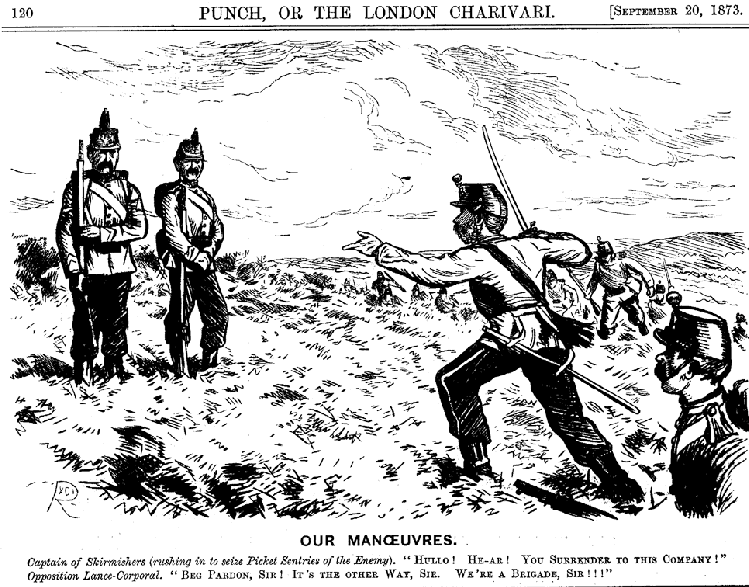
Another email
Dear HARC-MRL,
thanks for the tips, I am designing a taller angled block to hold 16 rounds
slightly in pairs with finger room between, this will hopefully help in
county comp I also shoot in with my modernish Anschutz, where 11 out of
11 is my best. I will also try a very narrow ring, easily done in perspex.
I was told that if you do not get many away through general slowness going
for pairs at each corner is a good start as they are easy to pick up in
the sight. I concur with the opinion fewer shots, but hits, is best.
I did shoot a few seasons with a 12/15 with a blade, it will meet the accuracy
but was slower for me.
My reason for not getting many shots away (apart from some age disadvantage,
failing eyesight, perhaps I should shoot with my driving glasses on) is
that a Vostock Strella does not have a loading ramp, mis-load and the round
is way below the breech and tricky to flick out with a finger, given flat
nosed Match ammo the feeding has to be precise.
Either way I've no complaints, nice comps, well run, keep up the good work.
The reply in part:
Dear .........,
..................it is very interesting to read of your experiences. The
perspex fore-sight element is fine for Post-Veteran, but technically out-of-class
for Veteran. We are aware of the "shoot at the corners" option,
but did not feel it was to be offered as best practice. It is a method which
can also cause you to "lose your place" once the eight available
shots at the corners have been used up!
...............................Kind regards, HARC-MRL.
Return to: TOP of PAGE
See this website's Raison d'être
